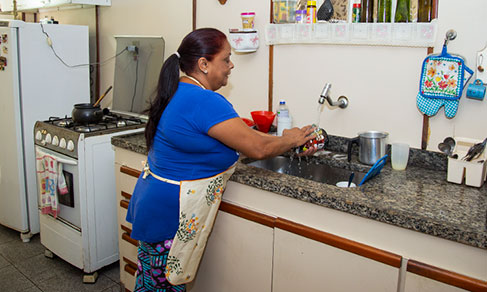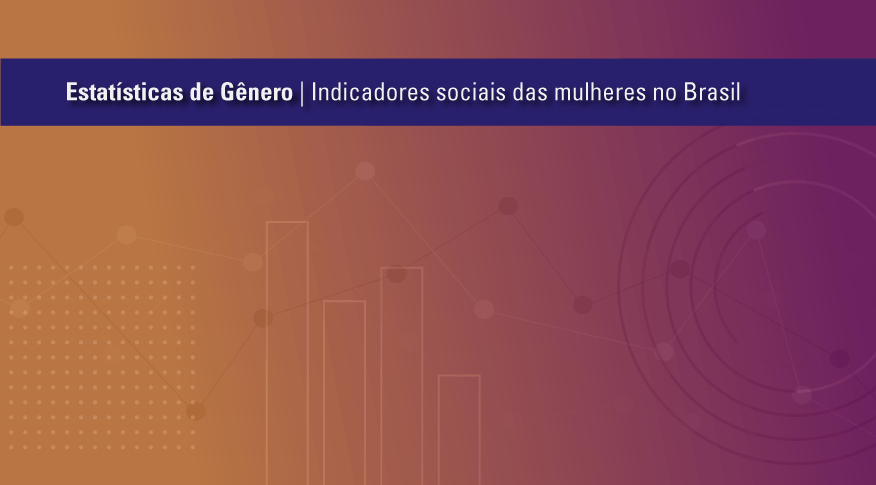Nossos serviços estão apresentando instabilidade no momento. Algumas informações podem não estar disponíveis.
Gender Statistics - Social indicators of women in Brazil
About - Gender Statistics - Social indicators of women in Brazil
In 2013, the United Nations Statistical Commission organized the Minimum Set of Gender Indicators - MSGI, comprising 63 indicators (52 quantitative and 11 qualitative ones) which reflect the effort to systematize information destined to national production and international harmonization of country and regional statistics about gender equality and women empowerment.
With the release of the current report, the IBGE brings for the first time to the public the results of a great part of those indicators for Brazil, contributing, thus, to the filling of an important gap in he production of gender statistics. The information is divided into the five domains established by the MSGI – Economic structures and access to resources, Education, Health and related services, Public life and decision-making, and Human rights of women and child – and they offer an overview, however concise, of gender inequality in the country, with valuable elements for reflection of those who study and design public policies. To build the 38 indicators hereby disclosed, data from the IBGE were used, for instance, from the Continuous National Household Sample Survey - Continuous PNAD, the National Household Sample Survey - PNAD, Population Projections by Sex and Age, Vital Statistics, National Survey of Health - PNS and Survey of Basic State Information - Estadic, as well as data from external sources from the Ministry of Health, the Presidency of the Republic, the National Congress, the Superior Electoral Court - TSE and the National Institute for Educational Studies and Research Anísio Teixeira - INEP. All indicators, it should be noted, are in line with the methodology recommended by the United Nations.
The present study complements the publication Gender statistics: an analysis of the 2010 Population Census, launched by the IBGE in 2014, in the scope of the National System of Gender Information - SNIG.
This report is also available on the IBGE Internet portal, which also includes the complete table plan with several disaggregation levels, a summary table with the 38 indicators for Brazil, as well as the technical notes on the study, containing, for each theme, a definition of the indicators according to the metadata defined by the United Nations, the statistical sources used and the respective calculation methodology.
This fact sheet is also disclosed in print. The technical notes on the study are disclosed separately and can be accessed only in digital media on this page. They present the objective of the study and, for each theme, the concepts of the indicators, according to the metadata established by the United Nations, statistical sources used and respective calculation methodology. The IBGE also discloses the complete table plan with several disaggregations and a summary table with the 38 indicators at Brazil level.
Tables - Gender Statistics - Social indicators of women in Brazil
Complete Tables
Economic Structure (in xls and ods)
Summary Table of Indicators (in xls and ods)
List of Tables (in pdf)
Publications - Gender Statistics - Social indicators of women in Brazil
Gender statistics : social indicators for women in Brazil
Material type: Book
Year: 2018
Description
In 2013, the United Nations Statistical Commission organized the Minimum Set of Gender Indicators - MSGI, comprising 63 indicators (52 quantitative and 11 qualitative ones) which reflect the effort to systematize information destined to national production and international harmonization of country and regional statistics about gender equality and women empowerment.
With the release of the current report, the IBGE brings for the first time to the public the results of a great part of those indicators for Brazil, contributing, thus, to the filling of an important gap in he production of gender statistics. The information is divided into the five domains established by the MSGI – Economic structures and access to resources, Education, Health and related services, Public life and decision-making, and Human rights of women and child – and they offer an overview, however concise, of gender inequality in the country, with valuable elements for reflection of those who study and design public policies. To build the 38 indicators hereby disclosed, data from the IBGE were used, for instance, from the Continuous National Household Sample Survey - Continuous PNAD, the National Household Sample Survey - PNAD, Population Projections by Sex and Age, Vital Statistics, National Survey of Health - PNS and Survey of Basic State Information - Estadic, as well as data from external sources from the Ministry of Health, the Presidency of the Republic, the National Congress, the Superior Electoral Court - TSE and the National Institute for Educational Studies and Research Anísio Teixeira - INEP. All indicators, it should be noted, are in line with the methodology recommended by the United Nations.
The present study complements the publication Gender statistics: an analysis of the 2010 Population Census, launched by the IBGE in 2014, in the scope of the National System of Gender Information - SNIG.
This report is also available on the IBGE Internet portal, which also includes the complete table plan with several disaggregation levels, a summary table with the 38 indicators for Brazil, as well as the technical notes on the study, containing, for each theme, a definition of the indicators according to the metadata defined by the United Nations, the statistical sources used and the respective calculation methodology.
This fact sheet is also available in print. The technical notes on the study are disclosed separately and can be only accessed digitally on this page. They present the objective of the study and, for each topic addressed, the definition of the indicators according to the metadata established by the United Nations, the statistical sources used and the respective calculation methodology. The IBGE also makes the complete table plan available, with several disaggregations and a summary table with the 38 indicators for the level Brazil.
Downloads
Technical Information
Gender Statistics - Social indicators of women in Brazil
The technical notes can be found in the publication below:
https://biblioteca.ibge.gov.br/index.php/biblioteca-catalogo?view=detalhes&id=2101551
News and Releases
Black and brown women spend more time in household tasks, participate less in the labor market and are more affected by poverty
In Brazil, black and brown women are more affected by inequalities in education, labor market, income...
08/03/2024
Gender Statistics: women’s employment is lower in households with children up to three years of age
In 2019, employment-population ratio among women aged 25 to 49 living in households with children up...
04/03/2021
Errata
Change in the indicators of gender parity of school attendendance rates and of female participation in management positions
Published date: 18/05/2018
Description: The error in the indicators of gender parity resulted from a problem in the syntax that generates the tables of indicators. The error in the indicator of management positions resulted from a failure in the process of compatibilization between the codes of occupations from the International Standard Classification of Occupations 2008 (ISCO-08) and the Classification of Household Occupations (COD).
Actions: Correction of the tables released; correction of the summary table; correction of the fact sheet; correction of the technical notes.





